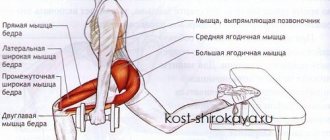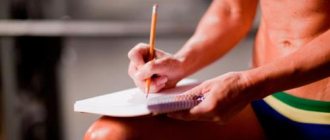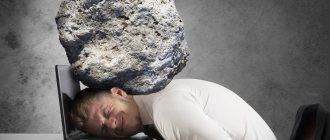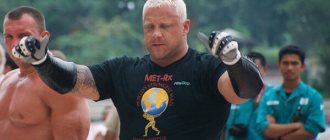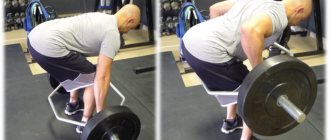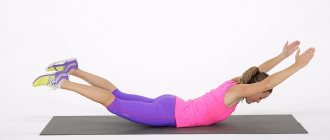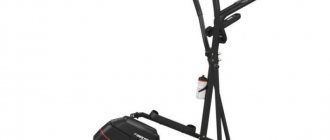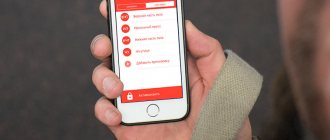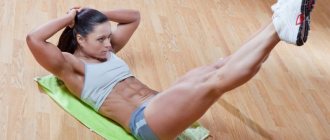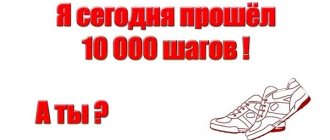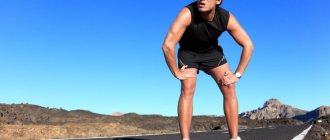To achieve ideal physical shape, you need to train a lot, and this statement also applies to your legs. Ideal, toned and slender legs are formed through many hours of grueling training. But you can achieve your goal faster and pump up your legs without extra effort. To do this, you need to determine the shape of your legs and build your training process based on exercises that are most suitable for you.
Finding out the shape is simple: you need to stand in front of the mirror and place your feet as close to each other as possible. Look closely at the reflection, paying special attention to the placement of the hips, knees, calves and ankles.
Legs bent outward
If you observe slightly bent knees when standing straight and they do not close together, it means that your legs have a curved (O-shaped) shape. To make them even, you need to bring your knees as close as possible. This effect is achieved by strengthening the muscles in the knee area.
Pistol squats
Single-leg squats, popularly known as pistol squats, are aimed at working the buttocks and thighs, in particular the inner thighs. Performed according to the following algorithm:
- Stand up straight.
- Raise one leg up.
- Squat down on your second leg, keeping the first leg straight.
- Perform 10 times for each leg.
Notes: You can use a wall or chair as support at first. Over time, you will no longer need it.
Four stretch
This exercise increases the flexibility of the thigh muscles. This is done as follows:
- Lie on your back.
- Place your right ankle on your left knee.
- Raise your legs.
- Take your left leg under your knee and hold for half a minute.
- Slowly return to your original position.
- Follow the same steps for the second leg.
Touching fingers
The exercise helps work the outer thigh and helps stretch the muscles. Performed in the following sequence:
- Stand up straight and spread your legs slightly to the sides.
- Bend over and try to touch your toes with your hands. Pay special attention to your knees: they should be together. If you are unable to keep your legs together, secure them with tape, for example.
- If this exercise seems easy to you and does not cause difficulties, you can raise your heels a little while doing it.
- Do the exercise 10 times.
https://youtu.be/-lGc05kh3Ek
Causes of possible foot pain after and during running
The appearance of unpleasant sensations in the leg after training or directly during running requires an obligatory clarification of their cause. If measures are not taken in time, serious complications are possible. A visit to the doctor should not be postponed if the leg is swollen and red. The symptom indicates the development of:
- injuries (fracture or crack) of the tibia or fibula;
- ankle arthritis;
- exacerbation of heel spurs;
- foot sprains.
Elderly people with osteoporosis suffer traumatic injury from light loads on the musculoskeletal system while jogging.
Less serious causes of leg pain include:
- the appearance of calluses and abrasions on the foot;
- muscle soreness.
To eliminate pain, it is often enough to purchase comfortable shoes designed for running. Jogging on a hard surface (asphalt) often leads to injury to the joints and causes an exacerbation of venous diseases. It is physiological to run on a special stadium surface, grass, sand.
Jogging is contraindicated for people diagnosed with flat feet.
If no pathology is identified, but the pain continues to bother you, you will need to adjust your running technique. Ignoring an unpleasant symptom will lead to the fact that jogging, instead of the expected benefit, will cause harm and provoke illness. When placing the leg, you need to choose a method that corresponds to the individual characteristics of the anatomical structure of the lower limb. It is important to adjust the correct running pace and increase the load gradually.
We present to your attention an approximate set of cross-split stretching exercises consisting of seven exercises. We remind you: immediately before performing stretching exercises, you need to warm up well and perform a good warm-up. This will increase the effectiveness of stretching and protect you from injury!
Butterfly
This exercise helps to develop eversion of the pelvic joints. 1. Sit on the floor, stretch your legs. 2. Bend your knees and touch the soles of your feet. 3. Pull your heels as close to your groin as possible. 4. Lower your knees as far down as possible and stay in this position for 30-60 seconds. Repeat 3-5 times. Execution options: 1) With a partner. You sit in butterfly pose. Your partner slowly lowers your knees down. 2) “The butterfly flaps its wings.” You sit in butterfly pose, but instead of statically pulling your muscles, you dynamically rock your knees up and down.
Leg fold apart
This exercise helps stretch your inner thighs and lower back. 1. Sit on the floor with your legs spread wide. 2. Place your hands on the floor between your thighs. 3. Without bending your knees and without lifting your feet off the floor, lean forward, sliding your hands along the floor.
Execution options: 1) Take this position, but lean not only forward, but also alternately towards each leg.
Folding legs together
The exercise is aimed at working the lower back and back of the thighs. When you pull your socks towards you, your hamstring muscles also stretch. 1. Sit on the floor 2. Straighten your knees, bring them together 3. Without bending your back, lean forward 4. Hold in the maximum stretched position for 30-60 seconds. Repeat 3-5 times. Execution options: 1) Sitting, 2) Standing. Important! In all areas of movement, keep your back straight!
Frog
Basic exercises for pelvic eversion. It also stretches the groin muscles well. 1. Kneel on the floor with your hands and forearms on the floor in front of you. 2. Slowly move your knees away from each other, spreading your legs. You should feel a gentle tension in your groin, but not pain. 3. Hold this pose for 5 to 10 minutes.
Rolling from foot to foot
Main goal: stretching the groin muscles. 1.Stand with your feet wide apart. 2. One foot is turned out, the other is facing forward. 3. Bend the knee of the leg whose foot is turned out, shift your body weight to this leg. This should straighten the other leg. 4. Without lifting your pelvis, repeat with the other leg. 5. The exercise is dynamic, there is no need to linger anywhere. 6. Do 9-15 rolls on each leg.
Deep bends while standing
The back of the thighs and lower back are stretched. It is performed in the same way as folding the legs together, with the only difference being that in this exercise the legs are spaced 30-40 cm apart from each other.
Split landing
1. Squat down with your knees wide apart. 2. Place your hands on the floor 3. Carefully, without sudden movements, spread your legs to the sides. 4. Try to keep your pelvis in line with your legs. 5. Hold in the maximum tension position for 30-60 seconds. Repeat 3-5 times
The complex should be performed daily, or every other day.
Have you been dreaming of doing the splits for a long time, but you can’t do it? Don't be discouraged - with the help of our method, which includes effective stretching exercises for the splits, you will certainly achieve your goal. You can do the splits at any age and for almost everyone. Therefore, throw your fears aside and boldly overcome self-doubt, and our exercises will help you.
Legs with knees pointing inward
If you stand straight with your hips as close as possible, but your shins are not touching each other, then you have a knee-in shape. Such legs are also called X-shaped. This form is formed due to weakened thigh muscles, both on the inner and outer sides.
Side lunges
Lunges are aimed at working the inner and outer thighs. Executed in this order:
- Stand up straight and place your hands on your hips.
- Take a long stride to the right. At the same time, bend your right leg at the knee, and leave your left leg straight.
- Repeat 10 times on each side.
Swing your legs on your side
When performing swings, the outer side of the thigh is loaded. This exercise is performed in this order:
- Lie on your side.
- Raise your top leg. During this, your legs should be kept straight or slightly bent.
- Repeat 10 times for each leg.
Lateral lifts
Lateral raises are effective for working the thighs. For this exercise, a step (fitness platform) is used; if it is not available, you can use a low, stable stool or chair.
- Stand to the side near the platform.
- Place your left foot on the step first.
- Raise your body completely, placing your other foot on the platform.
- Perform 10 times on each side.
Way. Gymnastic jump
The simplest and most popular type is the gymnastic method. It was primarily used by track and field athletes and gymnasts. In this case, you need to take a good run and jump just before the bar so that your two bent legs touch your chest. In this case, the landing occurs on two legs. This method requires a lot of skill, because you need to jump high and move the center of gravity over the bar without additional means.
Interesting: 5 ways to make an envelope
False curvature
When your knees touch each other, but the bottom part is separated and looks bony, then most likely your legs have a false bow. To correct this, you need to try to increase the volume of the lower leg muscles.
Raising your heels off the floor
This type of exercise increases the strength of the calf muscles. They are easy to do:
- Stand up straight.
- For balance, grab the surface of a wall or chair with your hands.
- Slowly stand on your tiptoes.
- Do 20 times.
Walking and running on stairs
Walking and running up stairs strengthens many muscle groups. A simple flight of stairs is all you need to practice walking.
Deep squats
Deep squats cause the muscles to contract, which stimulates blood circulation, making the exercise as effective as possible. Correct squats are performed using the following technique:
- Place your feet shoulder-width apart.
- Squat down as low and slowly as possible without lifting your heels off the floor. Ideally, squatting and rising from it should take at least 5 seconds.
- If this exercise seems too easy for you, raise your heels a little while doing it.
- Do it 5 times.
How to do the splits correctly?
There is a training program that will help you do the splits according to all the rules and not cause harm to the body. It consists of 3 stages:
- Active warming up of the muscles and ligaments of the legs;
- Quick warm-up;
- Exercises for splits.
Before classes, it is advisable to lie in a hot bath or dance vigorously - all this will help the muscles warm up faster.
To warm up the body we do:
- Lunges on both legs (forward and sideways);
- Smooth rolls from foot to foot;
- Push ups.
Exercises are performed for 15 minutes at an active pace. They will help you control your posture during the splits: keep your body straight, secure your body with your hands, and support your feet with your feet.
Normal form
If your legs touch each other at the top of your thighs, knees, calves and ankles, but there is little space between your ankles and half of your calves, then you have normal leg shape. You can call yourself lucky because you don't need to use training to correct your form. However, with the help of special exercises you will make your legs stronger and keep them in good shape.
Squats
Squats work a variety of muscle groups and are considered the most effective exercise for training the lower part. They need to be done as follows:
- Place your feet shoulder-width apart and sit smoothly.
- Control your back. It should remain straight.
- You can add weight to increase the load.
- Repeat squats 15 times.
Gluteal bridge
This type of load tones the muscles of the thighs and buttocks and is performed in the following sequence:
- Lie on the floor, legs should be bent at the knees, feet placed under the level of the knees.
- Lift your hips up and tighten your butt.
- Hold your position for a couple of seconds.
- Return to the original position.
- Do it 10 times.
Walking lunges
During this exercise, the entire leg is used, including the muscles located on the hips. The order of execution is as follows:
- Take dumbbells in your hands. Beginners are recommended to perform the exercise without additional weight.
- Take a wide step forward with your left foot.
- Bend the other leg at the knee, but it should not touch the floor.
- Perform 10 lunges using the technique described above, then turn around and walk to the starting point, performing lunges on the other leg. Make sure your front knee always forms a 90-degree angle.
Regardless of what data nature has awarded you, you are able to bring your legs to ideal condition. The exercises we have selected will definitely help you achieve maximum results in a short time.
What character traits does a person’s gait indicate?
If a person walks quietly, carefully stepping on his toes,
- he most likely does not like to attract attention to himself, is prone to introspection, is a little gloomy, is not very willing to come into contact with other people, is subject to sudden mood swings, is in love with himself and is overly self-confident.
A person with a so-called
“dancing” gait
is not serious, you should not trust him, such a guy or girl is unlikely to keep his word. People with such a gait like to “flutter”, that is, to relax, have fun, without thinking about the consequences and responsibility.
Girl clicking her heels excessively
, is trying to make himself known loudly.
She loves increased attention to her person. A sonorous gait with an accentuated click of heels
belongs to an unrestrained and unceremonious person. At first glance, this may seem like self-confidence, even courage. But such “boors”, knocking their heels, in fact often compensate for their lack of confidence with their behavior. They easily make love contacts and often change partners.
Fast or slow gait
depends on temperament and strength of impulses: restless-nervous – lively and active – calm and relaxed – sluggish-lazy (for example, with a relaxed, saggy posture, etc.).
People walking in small steps
, pedantic, picky, punctual and even a little boring. A gait with short steps in a person who is quarrelsome, vindictive, and irresponsible.
Arrogant, proud, ambitious people twitch their whole body when walking, especially their shoulders.
.
Wide steps
(more often in men than in women): often extroversion, determination, zeal, enterprise, efficiency. Most likely aimed at distant goals.
Slow step
in calm, indifferent, irritated people.
An emphatically wide and slow gait
– a desire to show off, actions with pathos. Strong and heavy movements should always demonstrate to others the strength and importance of the individual.
Slow and steady
people walk around, immersed in their affairs and thoughts, thoughtful, ambitious and selfish.
As a rule, they can move faster, but internal issues interest them much more than the constant rush. Also, romantics and people of creative professions - artists, poets, composers - are distinguished by their measured gait. This is the gait of scientists concerned about a scientific problem. Such people are very interesting, but are absolutely not adapted to life, so they constantly need a nanny - at 10 years old, at 20, and even at 60. A measured, sedate step
indicates that in front of you is a calm, balanced subject, not subject to eccentricities and frivolity. His rationality and conservatism may seem unbearable at times, but he is a loyal and reliable person.
Quick steps
.
A person who moves quickly, in small steps, according to psychologists, has a strong and purposeful character. According to statistics, people with such a gait achieve success in business and are distinguished by achievements in their careers. Typically, they often look around out of caution, are able to make quick decisions and can pull themselves together if necessary. He who walks with fast and long steps,
is generous, ambitious, diligent and efficient, always completes the work he begins.
a quick and quiet gait
.
Fast, uneven gait
- addicting nature. Such people rarely look at their feet, fly headlong, looking at everything that comes in their way - shop windows, people - and often stumble, even fall.
Measured steps, hands in pockets
-
usually tense and quite self-critical people with leadership qualities, as well as the desire to achieve success in everything and everywhere.
Defiant and bright,
attracting attention—mostly women. Their stride is refined and they love to twirl their hips and emphasize the way they walk. As a rule, owners of such a gait are absolutely confident in themselves and consciously try to attract as many eyes as possible to their person. Scientists have noted this style in many celebrities.
Loud and untidy step
. People with this type of gait also purposefully draw attention to themselves. But not because of excessive confidence, but because of tactlessness and lack of knowledge of etiquette. Owners of this manner are distinguished by their emotionality, which they can express as they want and where they want. Experts say that this step is typical for ladies' men and slackers.
With a light jazz gait
. People who don't look like they're walking, but seem to be dancing, have a frivolous and overly romantic character. They often express their emotions too violently and are not at all ashamed of it. According to statistics, men with such a gait are characterized by negligence in relationships.
Sincere and friendly people are
waving their arms Owners of this manner can easily listen to a friend, give advice and help in difficult times. They also have a cheerful character and a good sense of humor. Moreover, if at the same time the gait is light and free, this means that in front of you is an honest, kind person who you can trust. He is characterized by such traits as determination, swiftness, energy, and spontaneity. Most likely, this is a creative person.
The man who always walks in a straight line
, is usually brave and wise, ready for any troubles and is not going to give in to them. He is quite smart and brave, but he cannot be accused of recklessness and daring. This man is a pragmatist, but even within him there are sparks of romanticism, you just need to be able to kindle them. Such people are somewhat straightforward and uncompromising, which sometimes prevents them from making a career, but they are honest, although they carry their honesty around like a sack.
The one who walks quietly with his face up
- proud, arrogant and thoughtful.
A person who prefers to walk straight, but at the same time slowly and with his nose up
, is vain and arrogant, which is understandable even without any psychological calculations. Such people imagine themselves to be the center of the universe, and they simply hate those who try to knock down their arrogance.
Who pauses and looks around unnoticed?
- may turn out to be an arrogant and narcissistic slanderer.
Smooth, confident gait
speaks of a courageous, decisive, persistent and stubborn person. He loves sports and may even be a professional athlete. He is straightforward in his statements, which brings him a lot of trouble in life.
Slight forward bend when walking
- a sign of an honest, peace-loving and virtuous person.
Swinging gait
happens to a person who is talkative, courageous, sociable, and considers himself the smartest. Lively gestures speak of his self-confidence and impulsiveness. A sweeping gait is a sign of a generous and generous person. In addition to generosity, they are distinguished by diligence and diligence. They will never take on a task unless they are confident that they can handle it. And if you have already taken it, then rest assured - everything will be done in the best possible way.
The habit of tilting your head slightly to the right and spreading your legs wide when walking
, while vigorously waving your arms, placing your hand on your hip and looking directly at your interlocutor - such signs indicate innate nobility. These people are successful in all their endeavors, they are open, sociable, have an analytical mind, and are good psychologists.
Be especially wary of those who walk quietly, constantly looking around and stopping
. It is absolutely clear that these people have a guilty conscience. In addition, such a person’s gait characterizes a person as a low intriguer and slanderer with a very vulnerable pride.
Those who walk slightly leaning forward
As a rule, people are honest, straightforward and extremely peaceful. They are not capable of meanness and betrayal, but they are flexible enough not to seem impudent and rude. They will not bang their heads against the wall, trying to destroy it; they are smart enough to find a way to remove the obstacle in another, more effective way. They say about such people: “I would go on reconnaissance with him.” But even in peaceful life, they will always try to find a way out of the situation, so it is best to choose friends and lovers among people with such a gait, and you are guaranteed a faithful shoulder.
Timid and uncommunicative people walk with their toes inward
.
A man walking with his toes turned outward
- rather an extrovert. This person is sociable. And he is very focused on the people who surround him. He cares what people think of him. At least those whom he considers close. And it’s important for him to like him.
In people with their feet parallel
As a rule, orientations “towards oneself” and “towards people” are balanced: listens to the opinions of others, but only for additional information, without fanaticism; focuses on his opinion and defends his freedom, but without caring about everyone.
Constantly lifting up (on tense toes)
: upward striving, driven by an ideal, a strong need, a sense of intellectual superiority.
Women happy in love have a beautiful, flying gait
.
People with a sharp gait
They have a quarrelsome character, they are quick-tempered and vindictive. Their sharpness manifests itself not only in their gait, but also in their personal relationships.
Helpless, sluggish gait
- weak will, impotence, hidden diseases (tuberculosis, asthma, increased weight).
Rocking gait
- kindness, laziness, imposingness. Such people may poorly calculate the distances between themselves and other pedestrians, bump into oncoming people, and try to squeeze through the crowd. As a result, everyone is pushed, apologizes and collides again.
Pronounced relaxed gait
- lack of interest, indifference, aversion to coercion and responsibility, or in many young people - immaturity, lack of self-discipline, or snobbery.
Slow or “crane” step
characterizes people either indifferent, cold, or bilious, dissatisfied with everyone and everything. They are difficult to communicate, joyless and unpromising.
Shuffling, sagging gait
- refusal of volitional efforts and aspirations, lethargy, slowness, laziness.
Firm, angular, stilted, wooden gait
(unnatural tension in the legs, the body cannot sway naturally): tightness, lack of contact, timidity - hence, as compensation, excessive hardness, overexertion.
Gait of men:
Waddle"
. Characteristic of men who strive for social authority and want other people to listen to their opinions. They have an easygoing character, kindness, and are not vindictive.
Trembling gait
. Characteristic of nervous, insecure individuals with pessimistic moods in life. Such people cannot find the answer to the question: how to gain self-confidence?
Walking with hands in pockets
. Identifies people with pronounced leadership qualities. These people are also quite critical and mysterious.
The gait is swift with a sharp step
. Distinguishes people with a vengeful, conflictual character, very vindictive.
Smooth, leisurely gait
. Distinguishes people with a philosophical mindset, thoughtful and thoughtful.
Swift gait, hands on hips
. Characterizes a hot-tempered, unbalanced person. Periods of aggression are replaced by apathy. They prefer to make decisions quickly.
Walking with your chin high
. These are, as a rule, officials or responsible managers. A man with great ambitions and self-esteem.
"Springy" gait
usually belongs to athletes, including former ones.
Mild "clubfoot"
reveals shy and self-conscious people who prefer to spend a lot of time alone.
Heel-in gait
belongs to cheerful and sociable people. Those with this gait strive to understand the world around them.
Support leg concept
The supporting leg is the one around which the athlete rotates .
Reference! For a participant without a ball, either leg can be considered the supporting leg.
When assigning the ball, the support foot is set as follows:
when both feet are on the floor , then one acts as a support if the second has moved from its place or has come off the floor;- the foot that touches the floor automatically becomes the supporting foot if the basketball player was in motion before that;
- as a result of the movement of one foot, the second becomes the supporting one , if none of the feet had contact with the floor, and the player lowers himself onto two feet at the same time;
- when a basketball player lands on one foot , it becomes the supporting foot. In case the player pushes off with this foot and lands on two feet, then the supporting foot is not installed.
Rules
It's easier to succeed if you act wisely. Therefore, listen to the recommendations of experts in many videos about pumping the inner thigh.
- You need to start training after warming up;
- At the end of the set of exercises, stretch the muscles of the inner thigh;
- Don't forget about other muscles in your legs and body as a whole when pumping your inner thighs;
- Try to do the exercises correctly, don’t get distracted, pay attention to your technique;
- Periodically (every 2-3 months) change the nature of the load, without allowing the muscles to get used to it;
- Exercise regularly.
By following these rules, you will pump up your inner thighs, strengthen your legs, make them slim, fit, and attractive.
Main types of twine:
Cross split - with this exercise, the legs are spread apart.
- Longitudinal split - in this exercise, the legs are spread one forward and the other back.
- The main rule if you want to do the splits and not pull your muscles is to gradually load and follow the rule from simple to complex, that is, you should not fly headlong and try to do the splits, you should prepare properly for this and follow the basic rules of technique security:
- Do not hurry;
- Constantly perform exercises, preferably at least once a day in the morning, but better in the morning and before bed, this will not only improve your well-being but will also lead to the ultimate goal, namely to do the splits;
- Don’t forget to rest - if you don’t feel well or are too tired, it’s better to rest than to force your body;
- Burning is normal, pain is bad. It seems that everything is clear, but it should still be said that when stretching muscles and tendons, a slight burning sensation is a normal process, but in no case should stretching cause acute pain, if you feel pain when stretching, then it is better to perform the exercises under the supervision of a doctor, or at least having consulted with him;
- The training time should be from 10 to 30 minutes minimum;
A little physiology or which muscles work when performing longitudinal or transverse splits:
The main working muscles during longitudinal and transverse splits:
- Quadriceps femoris muscle;
- Rectus femoris muscle;
- Adductor longus muscle;
- Calf muscle;
- Gluteus maximus, etc.
So, after you have read about safety precautions and understood which muscles will be involved, let’s move on to the sweetest part, namely stretching exercises, but first I would like to remind you that every person is unique, so don’t be upset if you can’t do any of them exercises, just try a simpler one and when you can do it without straining, move on to a more complex one. All sorts of people treat me, for example, the physical education teacher always called me wooden)))
Equipment you may need:
- Walls;
- Yoga mat.
The set of exercises is designed for 10-30 minutes, it is advisable to perform each dynamic exercise 20-30 times on each side, static exercises are performed from 30 seconds to a minute.
Before performing the “splits in a few weeks” complex, it is advisable to do a warm-up and warm up the muscles, joints and ligaments; the best exercises for warming up are:
- Jogging;
- Bicycle or exercise bike;
- Bodyweight squats;
- Jump rope.
